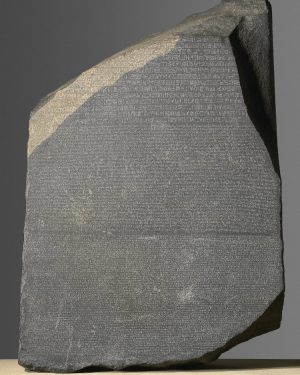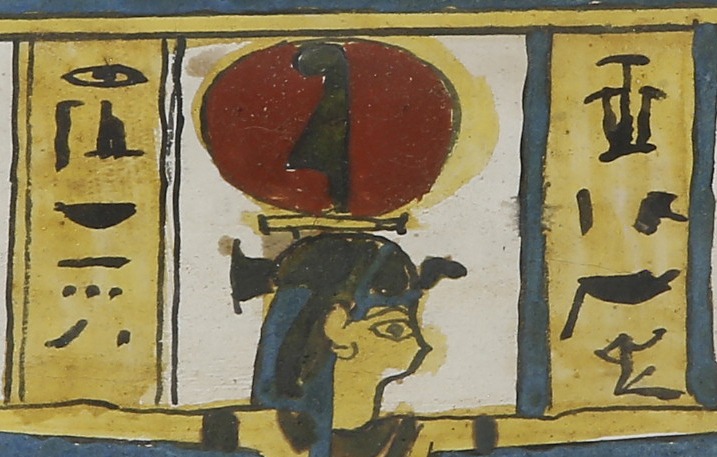Hieroglyphs: An Introduction to the Ancient Egyptian Writing System
A Brief History of Hieroglyphs
We owe the decipherment of Egyptian hieroglyphs to the French scholar and founding figure of Egyptology, Jean-François Champollion, and his decoding of the Rosetta stone, in the 1820s. Featuring both hieroglyphs and demotic (as well as Greek), the stone depicts two stages in Egypt’s written and spoken history. The Ancient Egyptian language, which differs markedly from today’s Egyptian Arabic, went through 5 stages. These were; Old Egyptian, Middle Egyptian, Late Egyptian, Demotic and Coptic. Appearing suddenly in 3000 BC, hieroglyphs emerged as a full system, unlike other symbolic languages which developed over time.
The term ‘hieroglyph’ derives from a combination of two Greek words ιερός (hieros) and γλύφω (glypho) and essentially translates as ‘sacred carvings’. The Egyptians themselves referred to their own language as ‘divine speech’. Hieroglyphic, as a whole system and as we know it today, is nothing more than simply the way the Ancient Egyptians recorded their language.
Hieroglyphs are split into three different groupings, depending on their use.
These are; ideograms, phonograms and determinatives (Middle Egyptian onwards).

The Three Groupings of Hieroglyphs
Ideograms
Ideograms are signs that represent the things they actually represent. For example, the symbol for a mouth is![]() , transliterated as ‘r’. The sign looks very much like a stylised mouth.
, transliterated as ‘r’. The sign looks very much like a stylised mouth.
Determinatives
Used in Middle Egyptian onwards, determinatives are signs placed at the end of a word to express that the symbols preceding it are phonograms. They usually indicate the general idea of the word.
Phonograms
Are signs that represent the sound they make. English, for example is made up fundamentally from phonograms, each sound of a word represented by a letter or combination of letters. The idea that symbols could represent sounds, rather than simply stand for the item they wished to represent, is known as the Rebus principle. It is a fundamental theory in the development of languages.
Take, for example, the adjective ‘I believe’. Using the Rebus principle, you would represent in images the sounds of each syllable.
Thus, I – be –lieve, would be written in Egyptian symbols as:
The hieroglyphs depicted – an eye, a bee and a leaf – have nothing however to do with the phrase ‘I believe’.
Where Did All the Vowels Go?
Ancient Egyptian is now classed as a ‘dead’ language, much like Latin. It was once spoken and written however in various forms. It was replaced in Egypt by Arabic in the 11TH century AD. We now have no way of knowing how words were spoken. Hieroglyphs, unlike English, did not use vowels. It consisted of consonants only, and it would have been only through the spoken language that the correct pronunciation of words would have been known. That is why you often see Egyptian names with various spellings. Some are more widely accepted but variations can exist. Take for example, the Egyptian sun god, known as Ra or Re.
Hieroglyphic writing had a core ‘alphabet’ of 25 consonants. They were uniliteral, made up of one letter, used in combination with other hieroglyphs. These 25 signs were the most common of symbols used and each word would contain at least one.
Following on from this idea, the Ancient Egyptians also used biliteral sounds (two-lettered). Using the Rebus principle , if you were to use the ‘leaf’ symbol ![]() to make up the ending of the word ‘belief’, ignoring the vowels, you would be left with a shorthand combination of ‘lf’. Thus, the leaf symbol could be used to write words with the same ‘lf’ combination in them, such as life or loaf.
to make up the ending of the word ‘belief’, ignoring the vowels, you would be left with a shorthand combination of ‘lf’. Thus, the leaf symbol could be used to write words with the same ‘lf’ combination in them, such as life or loaf.
Which Way to Go?

English, and many other European languages, reads from left to right. Arabic, as an opposite example, reads from right to left. Hieroglyphs, as aesthetic tools, were written in a number of ways, to fully complement the artistic piece they were placed on. So they could essentially be written from left to right, right to left (most commonly seen) and vertically.
One easy way of realising the direction of the text is to see which way the hieroglyphs face. For example, the hieroglyph of a seated man ![]() . Depicted as he is, he faces to the left, thus the text following reads from the left to the right. Any text in columns will appear from top to bottom.
. Depicted as he is, he faces to the left, thus the text following reads from the left to the right. Any text in columns will appear from top to bottom.
Hieroglyphics is a complex and beautiful writing system. The decipherment of the language during the 1820’s provided an insight into a culture steeped in mysticism. Even today, Egyptian antiquities collectors are drawn to pieces which feature hieroglyphs, their inclusion adding a further allure.
Filed under: Ancient Egypt, Imagery & Symbolism Tags: , Ancient Culture, Egyptian Deities, Egyptian Shabtis, Egyptian Tombs
Comments: Comments Off on Hieroglyphs: An Introduction to the Ancient Egyptian Writing System